
Brent Wilson’s filter strip, which feeds off his settling basin, isn’t
easy to spot. It runs into a field and is almost camouflaged amongst
the cornstalks. But it’s as effective as it is easy on the eyes.
Settling basin and filter strip work well at beef operation
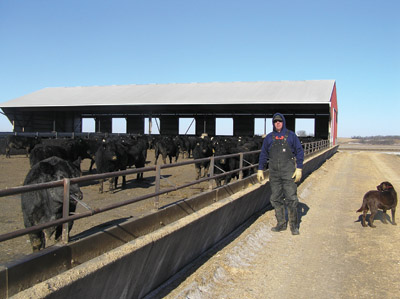 |
|
| Six years ago, Brent expanded his beef feedlot by adding three yards — each holding between 240 and 260 head. A fourth yard holds 160 cattle and the receiving yard holds about 80 head. Submitted photo
|
Brent Wilson’s filter strip, which feeds off his settling basin, isn’t easy to spot. It runs into a field and is almost camouflaged amongst the cornstalks. But it’s as effective as it is easy on the eyes.
Brent’s farm in Andover, Iowa, comprises two parts – a grain operation, where he rotates hundreds of acres of corn and beans, as well as a feedlot. Six years ago, he expanded the feedlot adding three yards — each holding between 240 and 260 head. Another yard holds 160 and the receiving yard holds approximately 80 head.
“It’s enough to keep three guys busy,” says Brent, who runs the farm along with two full-time employees.
The Wilson farm is definitely family-oriented. “I’m third generation, a second generation on this farm,” says Brent. “I followed in my father’s footsteps. He’s 84 and retired but still active. Not in the wintertime — he winters in Florida.”
Settling basin design
When Brent expanded to add the new yards, he also incorporated a 50-foot by 50-foot cement settling basin and a filter strip.
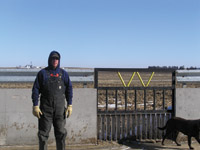 |
|
| The filter strip on Brent Wilson’s beef operation isn’t easy to spot. It feeds off his settling basin and runs into a field and is easily camouflaged amongst the cornstalks. Submitted photo |
|
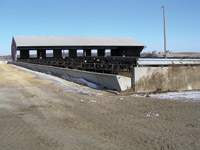 |
|
| If he had it to do over again, Brent would choose a monoslope barn with everything under one roof. Submitted photo |
|
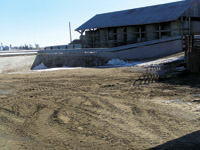 |
|
| When Brent added the new yards in 2002-2003, he also incorporated a 50-foot by 50-foot cement settling basin along with the filter strip. Submitted photo |
|
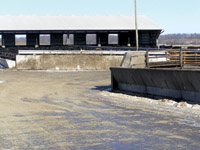 |
|
| The yards, settling basin and filter strip are all located on a relatively flat piece of land. Gravity powers the system, which also takes advantage of the rainfall in the area. The yards have a one percent slope into the cement settling basin, which then feeds into a filter that runs out in the corn field about 200 yards. |
He was able to secure some funding through the Natural Resources Conservation Service (NRCS). The service also helped with the design, as did Brent’s wife, Sonya, an engineer.
The NRCS also assisted with the funding of the manure spreader. But as far as building the structures and the new feed yard, “that was my own undertaking,” says Brent.
With the Wilsons doing a lot of the work themselves, the entire project took a good part of a year to complete.
The yards, the settling basin and the filter strip are all located on a relatively flat piece of land. It’s a gravity fed system that takes advantage of the rainfall in the area. The yards have a one percent slope into the cement settling basin, which then feeds into a filter that runs out in the corn field about 200 yards.
The system is fairly simple. “We generally scrape (the pens) twice a week, and we always try to scrape just before a rain event. When it rains, a picket fence holds back the solids from settling basin. We don’t try to hold any water.”
Brent says although the system works well, it isn’t perfect. “(Manure) is running fairly slow and the solids will settle out as it rains, for the most part. But there is a little bit that does go out.”
Solids and spreading
The solids that are scraped from the yards and collected from the settling basin are stockpiled outside.
“We stockpile all summer long and that summer stockpile will cover about 70 acres — which we’re doing now (early December),” says Brent. “Then our winter, spring and fall manure we’ll use to try to cover another 300 acres.”
Brent says he can spread nearly half the year. “We quit spreading around the first of May when the corn crops go in. Then we’ll stockpile until approximately September 15th when we do our silage. And then from 15th of September to around May 1st we’ll be putting it out on the field.”
He rotates the acres and tries to spread manure on a parcel every third year. Luckily, the Wilsons have enough acreage and they don’t need to find other farms to spread on. But even so, spreading is kept within a 10-mile radius.
The Wilsons use two Kuhn Knight spreaders — an 8132 and an 8142. “They will handle liquids to solids. And one is mounted on a truck so we can speed up the process,” says Brent. “We can unload a load in about 10 minutes.
Improvements to the system
Brent says the settling basin works well, but he would like it even better if manure could settle one more time so he could capture even more of the solids.
“I’ve been talking with the NRCS on this and they don’t think it’s necessary but I would like to have a little bit more settling,” he says. “I could scrape up outside my settling basin, have a cement pad . . . to have a little more time to settle out more yet.”
If he did it again
Although he’s pleased with the system, if he had it to do over again, Brent might choose different barns, in particular the monoslope buildings that were coming out at the time he built his barns. The monoslope is designed to be approximately 100 feet wide and several hundred feet long — basically a one-sided shed. In this way, everything is under a roof.
“I would have looked very heavily into possibly putting up a monoslope at the time we did this, but what I did was what was available then. And a total confinement system was too expensive,” says Brent.
Odors
The farm is located near a small community and Brent says odor is a concern that they “deal with all the time.
“The biggest thing we can do to keep odor down is to keep things scraped clean,” he says. In the summertime, they also haul their manure farther out where it’s at least three-quarters of a mile from any homes.
The stockpiled manure isn’t the Wilsons’ biggest concern when it comes to odor. “Our stockpile manure will crust over and you normally don’t have much odor after that except a little bit after a rain and then it seals over again,” says Brent. “The only time when odor on the stockpile becomes a concern is when we’re hauling it out. There is odor then.
“Normally we try to incorporate (the manure) within 48 hours,” Brent adds. “But it depends on the weather. For example, we got our crops out late this fall and our ground is frozen now so we’re kind of backed up against the wall and we’re top dressing it at this point. We’re hoping we get a warm spell so that we can incorporate it, but it’s not an ideal situation.”
Brent says this isn’t a normal situation for them — in 10 years they haven’t had this kind of trouble spreading. “Mother Nature just dealt us some different cards,” he says.
Water quality
The Wilson farm is about five miles from the Mississippi, at the very eastern tip of Iowa, near Clinton. Because they’re so close to the river, water quality is a big issue. But the news is good in their region.
“The water quality was checked and we’re gaining,” says Brent. “The last I heard, the Elk River watershed, where our farm is located, has seen improvements. Everybody is trying to do their part and it’s working. Everyone’s a better steward.”
He adds that local water gains are especially significant considering the large number of cattle in the immediate area.
Recommendation
After using the settling basin system for more than six years, Brent would definitely recommend it to other farmers with open lots.
He’s seen a couple more systems like his go in since they built theirs, and he attributes it to the smaller cattle operations.
“Anything over 1,000 head in one location has to be permitted. And there are very few in our local area that are over 1,000 head in one location,” says Brent.
When a farm is larger than 1,000 head, it must be permitted. Filter strips aren’t allowed and the runoff from the manure system must be 100 percent controlled.
“We get a fair amount of rain here. In fact, there’s no irrigated ground in our area at all. All our crops are raised non-irrigated — except for some irrigation along the river in some sandy areas,” says Brent, adding that means they deal with a lot of runoff.
In fact, rains this year were extreme and the flooding hit national news. With that kind of rainfall, a solid settling basin won’t work for more than 1,000 head and a lagoon must be installed.
A lagoon may very well be in Brent’s future. He has visions of expanding someday, but not now with the economy struggling.
“We’re just kind of drawing in our horns right now, seeing what happens,” he says. “But someday…”